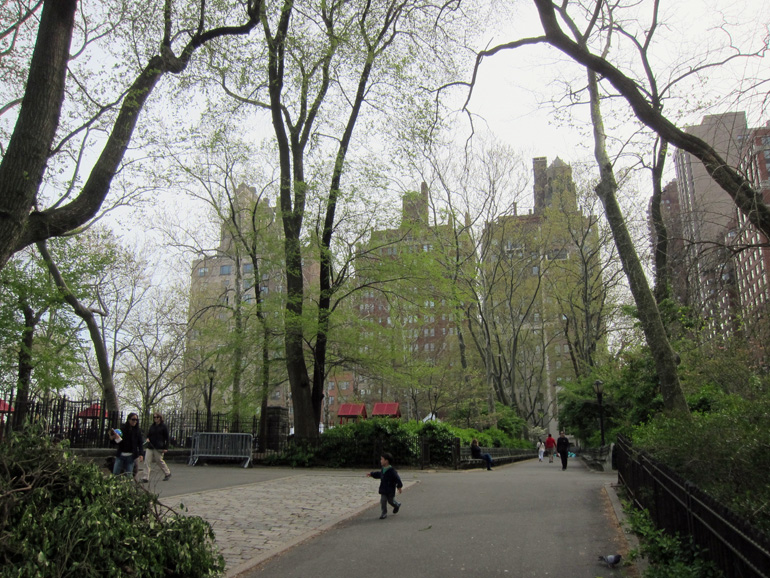Gotham Diary:
Adventure
2 May 2013
Thursday, May 2nd, 2013
As I was lying in bed, waiting to fall back asleep after a trip to the bathroom, the word “Alhambra” floated into my brain, and whatever current brought it there was broken by a sharp sense that I shall probably never see the Alhambra, nor, for that matter, set foot in Spain. The desire to do either has never been appreciable. It seems much harder that I might never make it to Italy, but, upon examination, the desire to visit Italy melts into an obligation, and quickly falls back further into a duty neglected in the past: I ought to have been to Italy by now. Now, with my stooped shoulders and rigid back, with my shortish stride and my disinclination for long walks, Italy would be rather wasted on me. In the night, the thought of never seeing the Alhambra was sentimentally sad, in a life-is-over sort of way that I had to snap myself out of. (Else I’d never have gone back to sleep.) This morning, I see the matter more clearly.
Physically, travel has become uncomfortable for me. But so has the very idea of “adventure.” I find myself wondering just how long ago it was that my willingness to play along with other people’s penchant for adventure became wholly inauthentic. Did I ever like adventures? Looking back, I see them as either frightening or disappointing. But then, I should never call walking around Paris or London or Amsterdam an “adventure.” I do not expect surprises in those cities any more than I expect them in New York. I rather dislike surprises, and will go out of my way to avoid the likelihood of being taken by them. I’m speaking of surprises in the street, as it were. I am ambushed by surprises in my mind every day. Some are more exciting than others, but collectively they satisfy my appetite for the unexpected.
There is, periodically, talk of another trip to Istanbul. Kathleen and I went there in 2005, and we were treated royally by our (business) hosts. Wasn’t that an adventure? How can I even think of saying that it wasn’t? I had such a good time that I was exhausted at the end of the week, or sick, actually; I came down with an allergic reaction to some medicine that I’d been taking — nothing to do with being in Istanbul, except that I was on the go every minute. (Up in the middle of the night, for example, blogging from the hotel’s business center; our wing had not yet been connected to the Internet.) Everything was extraordinarily interesting — everything! And it was all very comfortable, too. I learned a little Turkish, and daydreamed about living in a flat in BeyoÄŸlu, right around the corner, perhaps, from Orhan Pamuk, whose novel Snow I was reading.
I dream of living in flats in European cities all the time. That has nothing to do with travel.
***
Last week, I picked up a book that turned out to be a quick and pleasant read, Stephane Kirland’s Paris Reborn: Napoleon III, Baron Haussmann, and the Quest to Build a Modern City. The transformation of Paris in the Second Empire is an abiding interest of mine, possibly because there has never been anything like it but probably because it really did make Paris the most beautiful city on earth. Not necessarily the city with the most interesting monuments and landmarks — but then, I’m not interested in monuments and landmarks. I don’t want to see the ruins of the Parthenon because that’s all they are, ruins; the Athens that the Parthenon crowned disappeared well over a thousand years ago. I will admit to a strange desire to see how small the Roman remains are, and how small the baroque churches built alongside them. But civically, a monument interests me only to the extent that it is well-sited, and almost everything in Paris is right where it ought to be, thanks to its web of boulevards. The original boulevards took the place of the old city walls during the reign of Louis XIV, but they were by their very nature peripheral. Until the Rue de Rivoli was undertaken by Napoleon I, there were no such thoroughfares in the center of town. New streets were developed throughout the early Nineteenth Century, but it was under Napoleon III that the city that we know began to appear. Thousands of families were displaced by slum clearance, and crony capitalism created thousands of dubious fortunes. Georges Eugène Haussmann, the Prefect of the Seine for all but the last years of the “carnival empire,” was responsible for the heavy construction — the roads, aqueducts, sewers, and so forth. He had nothing to do with the design of the vernacular city buildings that still line the inner boulevards and give Paris its look of eternal serenity, which everyone attributes to him. There was nothing serene about Haussmann, a tyrannical workaholic. Haussmann was entirely Napoleon’s creature — that’s the point that Kirkland wants to make. The transformation of Paris was the Emperor’s doing. Kirkland is prevented from making his case with complete persuasiveness by a happy determination to avoid being tedious.
What I itched for, when I got to the end of Paris Reborn, was for a modern-day Plutarch to compare and contrast the careers of Georges Eugène Haussman and Robert Moses. Having said that, I see that I have something else in mind. Moses, even more dictatorial than Haussmann, and nobody’s creature, made large-scale urban renewal projects politically unthinkable, but we’re going to have to think again if New York is to continue to develop. It seems obvious to me — only to me, I’m afraid — that the future of New York lies in a reconception of Queens County as a more highly concentrated residential quarter, with buildings of “Haussmannian” proportions replacing single-family homes and larger apartment buildings lining the thoroughfares. Where is the vision to come from for this? Whence the political muscle? Whatever happens, the stories of Haussmann and Moses are replete with cautions.


